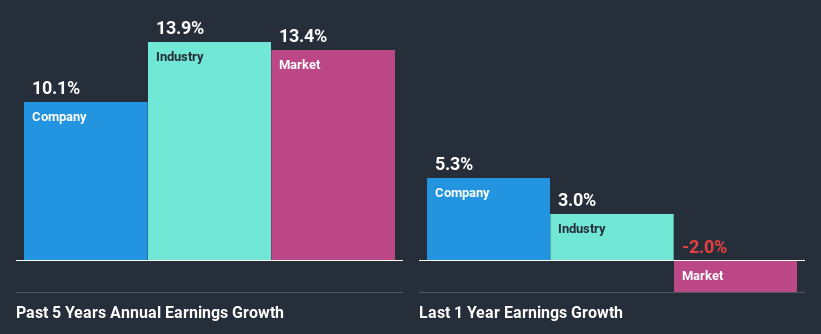National Retail Properties, Inc.'s (NYSE:NNN) Stock Has Seen Strong Momentum: Does That Call For Deeper Study Of Its Financial Prospects?

Most readers would already be aware that National Retail Properties' (NYSE:NNN) stock increased significantly by 16% over the past three months. As most would know, fundamentals are what usually guide market price movements over the long-term, so we decided to look at the company's key financial indicators today to determine if they have any role to play in the recent price movement. In this article, we decided to focus on National Retail Properties' ROE.
Return on Equity or ROE is a test of how effectively a company is growing its value and managing investors’ money. In short, ROE shows the profit each dollar generates with respect to its shareholder investments.
View our latest analysis for National Retail Properties
How Do You Calculate Return On Equity?
ROE can be calculated by using the formula:
Return on Equity = Net Profit (from continuing operations) ÷ Shareholders' Equity
So, based on the above formula, the ROE for National Retail Properties is:
6.6% = US$285m ÷ US$4.3b (Based on the trailing twelve months to March 2020).
The 'return' is the profit over the last twelve months. One way to conceptualize this is that for each $1 of shareholders' capital it has, the company made $0.07 in profit.
Why Is ROE Important For Earnings Growth?
We have already established that ROE serves as an efficient profit-generating gauge for a company's future earnings. We now need to evaluate how much profit the company reinvests or "retains" for future growth which then gives us an idea about the growth potential of the company. Generally speaking, other things being equal, firms with a high return on equity and profit retention, have a higher growth rate than firms that don’t share these attributes.
National Retail Properties' Earnings Growth And 6.6% ROE
At first glance, National Retail Properties' ROE doesn't look very promising. Although a closer study shows that the company's ROE is higher than the industry average of 5.4% which we definitely can't overlook. This probably goes some way in explaining National Retail Properties' moderate 10% growth over the past five years amongst other factors. That being said, the company does have a slightly low ROE to begin with, just that it is higher than the industry average. So there might well be other reasons for the earnings to grow. For example, it is possible that the broader industry is going through a high growth phase, or that the company has a low payout ratio.
We then compared National Retail Properties' net income growth with the industry and found that the company's growth figure is lower than the average industry growth rate of 14% in the same period, which is a bit concerning.
Earnings growth is a huge factor in stock valuation. The investor should try to establish if the expected growth or decline in earnings, whichever the case may be, is priced in. This then helps them determine if the stock is placed for a bright or bleak future. One good indicator of expected earnings growth is the P/E ratio which determines the price the market is willing to pay for a stock based on its earnings prospects. So, you may want to check if National Retail Properties is trading on a high P/E or a low P/E, relative to its industry.
Is National Retail Properties Efficiently Re-investing Its Profits?
National Retail Properties has a high three-year median payout ratio of 89%. This means that it has only 11% of its income left to reinvest into its business. However, it's not unusual to see a REIT with such a high payout ratio mainly due to statutory requirements. Despite this, the company's earnings grew moderately as we saw above.
Besides, National Retail Properties has been paying dividends for at least ten years or more. This shows that the company is committed to sharing profits with its shareholders. Based on the latest analysts' estimates, we found that the company's future payout ratio over the next three years is expected to hold steady at 75%. Still, forecasts suggest that National Retail Properties' future ROE will rise to 7.9% even though the the company's payout ratio is not expected to change by much.
Summary
In total, it does look like National Retail Properties has some positive aspects to its business. Its earnings have grown respectably as we saw earlier, which was likely achieved by the company reinvesting its earnings at a decent rate of return. Still, its earnings retention is quite low, so we wonder if the company's growth could be higher, were it to pay out less dividends and retain more of its profits? On studying current analyst estimates, we found that analysts expect the company to continue its recent growth streak. To know more about the company's future earnings growth forecasts take a look at this free report on analyst forecasts for the company to find out more.
This article by Simply Wall St is general in nature. It does not constitute a recommendation to buy or sell any stock, and does not take account of your objectives, or your financial situation. We aim to bring you long-term focused analysis driven by fundamental data. Note that our analysis may not factor in the latest price-sensitive company announcements or qualitative material. Simply Wall St has no position in any stocks mentioned.
Have feedback on this article? Concerned about the content? Get in touch with us directly. Alternatively, email editorial-team@simplywallst.com.

 Yahoo Finance
Yahoo Finance 
